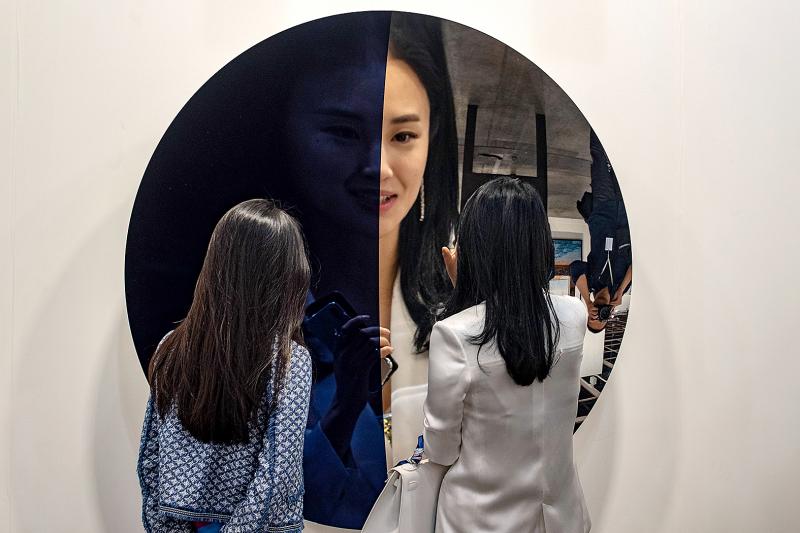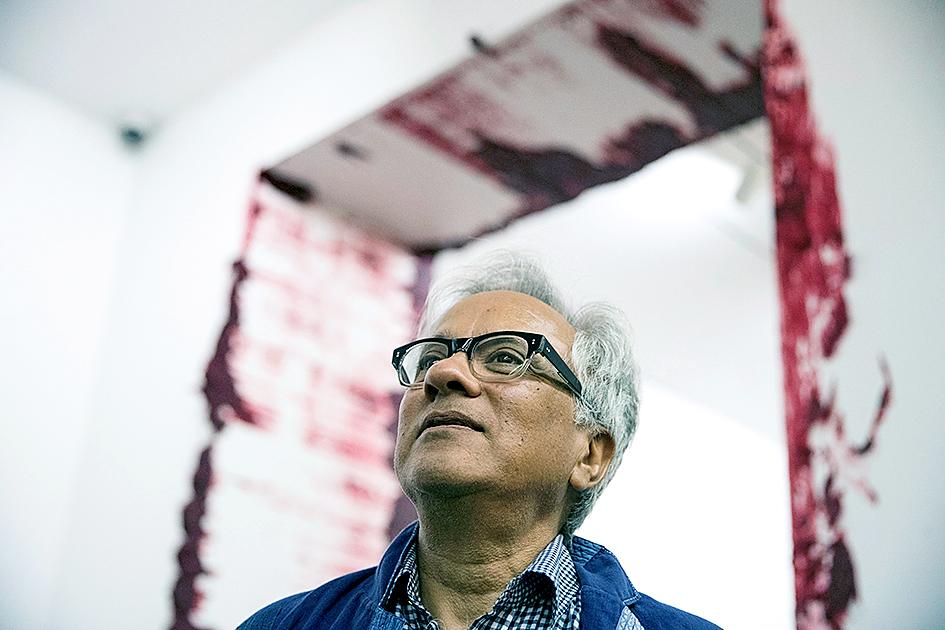British-Indian artist Anish Kapoor , 66, is mounting his largest-ever UK exhibition of outdoor sculpture at Houghton Hall in Norfolk from late this month, including his famous Sky Mirror, a five-meter stainless steel disc that turns the world around it upside down.
Sarah Crompton: What kind of things did you want to show at Houghton Hall?
Anish Kapoor: It’s one of the great houses of England, with a great history, and extensive grounds. I decided the stone works that I’ve made over the past 25 years, and I’ve never shown in the UK before, would sit quite well there. Then it felt right to put in some mirror works, and put the Sky Mirror in the grounds. It came together as quite a precise project.

Photo: EPA-EFE
SC: What are you investigating with the stone sculptures?
AK: Most stone carving, over the last centuries, has been to have a block of stone, and then carve, like Michelangelo did, from outside in. What I’ve been doing, perversely, is to carve the interior. The block stays as it was quarried, and then I’ve been working on the inner form.
SC: Do you have a sense of yourself when you mount a retrospective exhibition?

Photo: AFP
AK: Yes, inevitably. I don’t like retrospectives, really. I’m looking to bring to life bodies of work that I hope make sense together. I seem to have a disjointed practice, because on the one hand I’m making these very geometric, very pure objects; and on the other my work is messy and all over the place — whether it’s a great pile of wax or these ritualistic paintings that I am making for an exhibition at the Modern Art Oxford gallery in September. Yet they are one practice — and they are, in a way, very similar to each other.
SC: What’s your overarching description of what you do?
AK: Oh God, I’ve no idea! [Laughs] I really do feel very strongly that I have nothing to say; I have no message to give the world and nor do I want to give the world a message. What I’m looking to do is to make objects that question the nature of objects — stones that are empty; heavy that’s not heavy, black objects that veil themselves?

Photo: EPA-EFE
SC: The black objects you are making with Vantablack, the world’s darkest black substance, will be shown for the first time in the Accademia in Venice next year. They are thrilling.
AK: I’m very excited by them. The material is, in a way, mythological. Imagine being able to describe a material as the blackest in the universe — including black holes. That’s kind of daft, isn’t it?
SC: How do you think it is now for young artists?

Photo: EPA-EFE
AK: Incredibly difficult. I think the art world is in severe difficulty. At one level, it’s booming. But what does that mean for artists? We are not makers of luxury goods.
I am part of that system too, so I’m not speaking as an outsider. But if everything’s for sale, how is it possible to find anything that’s radical? It’s so hard to maintain one’s distance from the commodification of the object.
And for young artists today, it’s impossibly hard to find space in London, it’s so goddamn expensive. When I first had a studio in east London in the early 80s it cost £5 a week...
SC: What advice would you give to someone starting out?
AK: It’s taking your metier as an artist thoroughly, absolutely, totally seriously. It’s not a part-time activity it is what we do all the time. Perseverance and endurance, or something like it, that’s what you need.
SC: Do you still work every day?
AK: Oh yes, I have a practice. I think Mae West once said: “I’m so tired of being admired.” I’m so tired of being inspired. Inspiration is marvellous, but it’s not really about that. I work a very normal day, 8.30am to 7pm, five days a week — I don’t work on a weekend. And it’s through the practice of working that things occur. It doesn’t matter what you do. Just do it.
SC: You were vocally opposed to Brexit. What’s your feeling now?
AK: It continues to be a disaster. Psychically it’s about where we are and how we see ourselves. This idea that Britain can do special deals and play a big nation I think it’s a fantasy. An isolationist, sad fantasy. Yet political discourse has almost ceased on the subject. I hope it will return.
SC: Would it make you think about leaving?
AK: I’ve had serious thoughts about leaving. And sad thoughts, because I’ve been here 40 years.
SC: Why do you feel the need to speak out?
AK: We’re all citizens, and as citizens we have a voice. I feel it’s important to engage, but I do believe that’s different from agitprop.
My art has its political position but it isn’t speaking in a political voice. But as a citizen I do! And so, stupid or otherwise, I’ll continue.
SC: You’ve recently managed to stop the National Rifle Association of America using an image of your Chicago sculpture Cloud Gate in one of their films?
AK: Yes, I did. They put out a vile little film using public objects as images of the so-called liberal invasion of traditional American space. I thought the whole way it was done was revolting, so I decided to fight on the basis of copyright. A group of American lawyers took it on pro bono, and I agreed to pay their expenses. They say it was the first action to cause the NRA to retreat from a position , and they’ve been retreating ever since. Yay!
SC: On the subject of public sculpture, The Orbit, which you designed for the Olympic Park in east London, is apparently losing a lot of money?
AK: It was made as a public sculpture, then Boris Johnson, in his previous incarnation [as mayor of London], turned it into a — what do they call it? — a visitor attraction. Oh, Jesus! I could have had a war with him, but I didn’t want to. But it always was a bad idea, according to me. Either you do something as a public object, or it’s a commercial enterprise. To mix the two up is confusion. It doesn’t work.
SC: Generally, you always seem enthusiastic and curious. Is that true?
AK: I’m an idiot, you know. Just deeply engaged in what I’m doing. I’m not interested in doing what I know how to do. I’ve just had my 66th birthday and I hope I can work with the same kind of idiotic enthusiasm that I had when I was 20.

We lay transfixed under our blankets as the silhouettes of manta rays temporarily eclipsed the moon above us, and flickers of shadow at our feet revealed smaller fish darting in and out of the shelter of the sunken ship. Unwilling to close our eyes against this magnificent spectacle, we continued to watch, oohing and aahing, until the darkness and the exhaustion of the day’s events finally caught up with us and we fell into a deep slumber. Falling asleep under 1.5 million gallons of seawater in relative comfort was undoubtedly the highlight of the weekend, but the rest of the tour

Youngdoung Tenzin is living history of modern Tibet. The Chinese government on Dec. 22 last year sanctioned him along with 19 other Canadians who were associated with the Canada Tibet Committee and the Uighur Rights Advocacy Project. A former political chair of the Canadian Tibetan Association of Ontario and community outreach manager for the Canada Tibet Committee, he is now a lecturer and researcher in Environmental Chemistry at the University of Toronto. “I was born into a nomadic Tibetan family in Tibet,” he says. “I came to India in 1999, when I was 11. I even met [His Holiness] the 14th the Dalai

Following the rollercoaster ride of 2025, next year is already shaping up to be dramatic. The ongoing constitutional crises and the nine-in-one local elections are already dominating the landscape. The constitutional crises are the ones to lose sleep over. Though much business is still being conducted, crucial items such as next year’s budget, civil servant pensions and the proposed eight-year NT$1.25 trillion (approx US$40 billion) special defense budget are still being contested. There are, however, two glimmers of hope. One is that the legally contested move by five of the eight grand justices on the Constitutional Court’s ad hoc move

Stepping off the busy through-road at Yongan Market Station, lights flashing, horns honking, I turn down a small side street and into the warm embrace of my favorite hole-in-the-wall gem, the Hoi An Banh Mi shop (越南會安麵包), red flags and yellow lanterns waving outside. “Little sister, we were wondering where you’ve been, we haven’t seen you in ages!” the owners call out with a smile. It’s been seven days. The restaurant is run by Huang Jin-chuan (黃錦泉), who is married to a local, and her little sister Eva, who helps out on weekends, having also moved to New Taipei